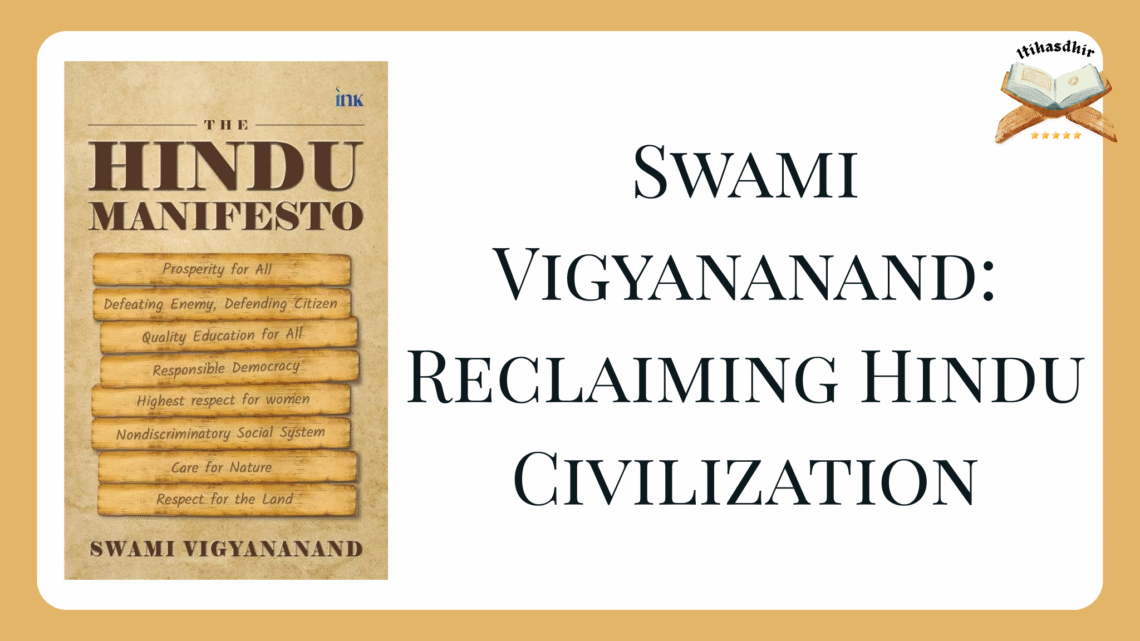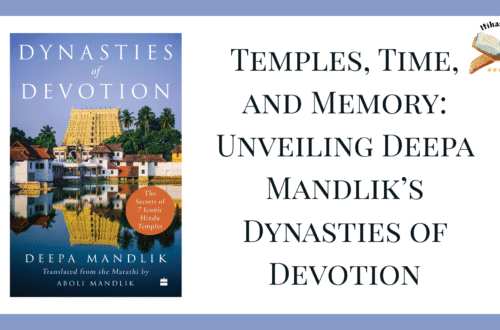
Swami Vigyananand’s “The Hindu Manifesto” Offers a Civilizational Roadmap
There are books that inform, repositories of facts, footnotes, and frameworks.
There are books that inspire, kindling within the reader a momentary flame of idealism, a fleeting vision of something greater.
And then, there exist those rare and potent texts that do more than inform or inspire, they awaken.
They rouse the soul from its civilizational slumber.
They summon the dormant spirit of a people long chained by forgetfulness, distortion, and disinheritance.
Swami Vigyananand’s The Hindu Manifesto is one such text.
It is not merely a political treatise, nor just a spiritual commentary.
It is a clarion call sounded across the corridors of time, a conch blown at the cusp of epochs, awakening the memory of a civilization that once stood as the spiritual spine of the world.
Here, the ancient and the immediate converge.
The wisdom of the Vedas walks hand in hand with the vocabulary of governance.
The soul of Sanatana Dharma speaks not in abstraction, but in strategic imperatives, urgent, lucid, and uncompromising.
This is a manifesto in its truest and most sacred form:
Not a partisan pamphlet, not a technocratic white paper,
But a declaration of intent forged in the sacred fire of Dharma.
A living articulation of what Bharat was, what it is, and, more crucially, what it must become.
Swami Vigyananand envisions Bharat not merely as a modern republic demarcated by lines on a map, but as a living embodiment of Sanatana Dharma, eternal, radiant, and sovereign.
A civilization not defined by territory alone, but by its spiritual architecture, its moral grammar, its cosmological rootedness.
This is a call to rebuild Bharat not as a nation-state alone, but as Rashtra, a sacred polity where Dharma animates every organ of collective life, from economics to education, from ecology to ethics, from polity to pilgrimage.
In doing so, The Hindu Manifesto bridges śāstra and śakti, tradition and transformation, memory and mission.
It speaks in the idiom of the future, but breathes the breath of millennia.
It reminds us that our civilizational strength lies not in mimicry of the West, but in remembering who we are, what we stand for, and why we must stand up now.
This is a document that does not merely argue.
It invokes.
It does not just instruct.
It initiates.
And above all, it demands not just reading, but responding.
The Visionary Behind the Manifesto: Swami Vigyananand
To understand the soul of The Hindu Manifesto is to recognize the stature of its author, Swami Vigyananand, a name that does not merely denote a person, but evokes a movement.
Swami Vigyananand is no ordinary writer, and The Hindu Manifesto is no ordinary book. He is a monk with the mind of a technocrat and the soul of a ṛṣi, standing at the confluence of scientific precision and spiritual insight. An alumnus of IIT Kharagpur, trained in the rigors of modern science, and a master of Sanskrit grammar and Vedantic philosophy, steeped in the eternal rhythms of śāstra and śruti, Swami ji embodies a rare integration. He has walked the corridors of academia and the silent sanctums of dhyāna, offering a synthesis that is both ancient and avant-garde.
His contributions extend far beyond the written word. As the founder of the World Hindu Congress and the World Hindu Economic Forum, Swami ji has not merely built institutions, he has built platforms of civilizational resurgence. These are not isolated initiatives but coordinated fronts that span economics, education, media, politics, and spirituality, domains often neglected in post-colonial Hindu discourse. His work is not that of a reformer tinkering at the edges, it is the architecture of a renaissance.
He represents a rare synthesis: the detachment of a sannyāsin with the strategic foresight of a statesman. His life exemplifies the Bhagavad Gītā’s ideal of nishkāma karma, action without selfish desire, service without ego, and vision without vanity. In The Hindu Manifesto, his voice is not that of a commander barking orders, but of a seer inviting awakening, firm yet compassionate, assertive yet anchored in humility.
Swami Vigyananand’s broader contribution lies in offering a cohesive, comprehensive, and actionable Hindu worldview, one that speaks to the 21st century with authenticity and authority. He offers not just critique, but construction; not merely protest, but proposal. In a world adrift in ideological fragmentation and civilizational confusion, he offers Dharma as the stabilizing axis, timeless in its essence, tested through history, and triumphant in its potential.
This is the spirit that animates The Hindu Manifesto, not as an academic dissertation, nor as political rhetoric, but as a sacred transmission from a life deeply lived in the service of Sanatana Dharma.
The Eight Sutras: Pillars of a Dharmic Society
At the heart of The Hindu Manifesto lies a radiant constellation, eight Sutras, or aphoristic principles, not merely points of policy, but pulses of perennial truth. These are not innovations born of modernity’s restlessness, but revelations distilled from civilizational experience, each Sutra a luminous thread in the grand tapestry of Sanatana Dharma.
Swami Vigyananand does not construct a manifesto around transient ideologies or imported isms. Instead, he excavates from the civilizational soil of Bharat those timeless truths that have nurtured a society capable of embracing plurality, sustaining harmony, and aspiring to moksha even amidst material life.
These Sutras are more than ethical guidelines. They are cosmic principles applied to collective living, echoing the rhythm of Ṛta (cosmic order) in the mundane mechanics of modern governance and social life. Together, they form a Dharmic Mandala, a complete vision of human flourishing rooted in spiritual realism.
I. The First Movement – Foundations of Power and Prosperity
The first four Sutras form the structural foundation, the pillars upon which any enduring civilization must be raised. They represent Kṣetra (the field of action), where Dharma is to be enacted in the spheres of economy, polity, education, and security. Without strength, knowledge, and sovereignty, no culture, no matter how noble, can survive the corrosions of time or the invasions of ideology.
- Prosperity (Artha) with Dharma as Guide
“Dharmasya mūlam arthaḥ” – Wealth is the root of Dharma, but only when it flows through ethical channels.
The manifesto reclaims economic growth as a sacred duty, not a capitalist excess. It demands the pursuit of wealth not for hoarding, but for service, stability, and social welfare. - National Security (Rakṣā) as Kshatriya Duty
True to the Kshatriya ideal, the nation must be ever-vigilant. Security here is not just militaristic, it is civilizational protection. A dharmic society must be defended from external threats and internal subversion, for without rakṣā, even the noblest ideals crumble. - Quality Education (Vidya) as Enlightenment and Empowerment
A civilization without śikṣā is a body without breath. The manifesto calls for restoring Gurukul-inspired education, rooted in critical inquiry, spiritual vision, and national pride, yet seamlessly integrating modern scientific advancement. - Responsible Democracy (Loktantra) as Ethical Governance
In invoking Ram Rajya, Swami Vigyananand reframes democracy not as a numbers game but a spiritual trusteeship. Leaders must be rajṛṣis, governing not for power, but for Dharma, justice, and the welfare of all beings.
These four Sutras are not merely statecraft. They are rajanīti infused with ṛṣi-dṛṣṭi, governance guided by seer-vision.
II. The Second Movement – Sustainers of the Soul
The latter four Sutras shift from the outer to the inner, from strength to sustainability, from statehood to soulhood. They are the prāṇa of Dharma, the animating breath that ensures not just survival, but sanctity. These principles preserve the civilizational essence, safeguarding values that are often unseen, yet deeply felt.
- Respect for Women (Strī-sammāna) as Shakti Reverence
The manifesto proclaims what the Vedas long declared, “Yatra nāryastu pūjyante ramante tatra devatāḥ”
Where women are honored, there the divine resides.
In a time of commodification and exploitation, this Sutra restores the sacred dignity of womanhood, not just in rights, but in ritual, reverence, and representation. - Social Harmony (Sāmañjasyam) beyond Colonial Constructs
Rejecting the divisive colonial and Marxist misinterpretations of varṇa and jāti, this Sutra urges a return to an organic, karma-based social vision.
It does not flatten differences but celebrates diversity with dignity, fostering unity without uniformity. - Environmental Care (Pṛthvī-pūjanam) as Sacred Ecology
Ecology here is not environmentalism born of climate crisis, but Bhūmi Sūkta in action.
Nature is not a resource, but divinity incarnate. The earth is Mātā, the rivers are sisters, the forests are sages. This Sutra calls for ecological dharma, not out of fear, but out of filial devotion. - Reverence for the Motherland (Bhūmi Bhakti) as National Dharma
The final Sutra anchors the entire manifesto in bhakti for Bhārata Mātā.
Patriotism here is not parochial, it is spiritual loyalty to a sacred geography. Bharat is not just a nation; it is the very altar upon which countless sages, warriors, and saints have offered their tapas.
Together, the Eight Sutras Form a Living Mandala
When viewed as a whole, the eight Sutras are not eight isolated proposals. They are interconnected petals of a spiritual lotus, each nourishing and sustaining the others.
Prosperity without ethics degenerates into greed.
Security without cultural pride becomes tyranny.
Education without identity fosters alienation.
And democracy without Dharma collapses into chaos.
By reuniting outer strength with inner sanctity, The Hindu Manifesto presents a civilizational grammar, a way for Bharat to be not just modern, but meaningfully modern. Not just global, but gloriously rooted.
Scriptural Elegance Meets Strategic Clarity
The writing of The Hindu Manifesto is not crafted merely with ink and intellect, it is forged in the fire of tapasya, of lived experience, of uncompromising dharmic clarity. The style is not ornamental for its own sake, nor austere for the sake of asceticism. It is instead a balanced synthesis, lucid yet layered, evocative yet exacting, profound yet practical.
Swami Vigyananand writes as one who has seen with inner eyes and walked with the weight of history upon his shoulders. His prose carries the resonance of a ṛṣi and the strategic precision of a statesman. It does not seek to dazzle the reader with rhetorical flourish, but rather to pierce the fog of confusion, to clarify, to consecrate, and ultimately, to call to action.
His diction is deliberate, each word chosen not for aesthetic flourish alone, but for its śakti, its force and fidelity to truth. He draws from the deep reservoirs of Sanskritic thought, invoking terms such as Dharma, Rashtra, Varna, Shakti, Ram Rajya, not as esoteric relics, but as living concepts, rich with relevance and ready to be reinhabited by a forgetful people.
The rhythm of his sentences flows like a sacred river, sometimes gentle and meditative, other times thunderous with urgency. There is a Vedic cadence to the structure, a kind of mantric intensity that elevates the text from political discourse to philosophical invocation.
What is most striking is that the style remains accessible without dilution. Swami Vigyananand resists the temptation to simplify Dharma into digestible slogans. Instead, he respects the reader’s intelligence and intuition, trusting that clarity need not come at the cost of depth.
The tone oscillates between scholarly exposition and spiritual exhortation. At times, it feels like a policy paper rooted in empirical reasoning; at other moments, it rises to the level of śruti, something heard through the soul, not just the intellect.
There is a palpable moral authority in the voice of the author, not born from arrogance, but from inner alignment with Sanatana Dharma. This is not the voice of one merely theorizing about Hindu civilization; this is the voice of one serving it with sacred urgency.
In essence, the style of The Hindu Manifesto is a literary yajña, a sacrificial fire where the offering is truth, the flame is intention, and the smoke is awakening. It leaves the reader not just informed, but initiated. Not just persuaded, but purified.
The Hindu Manifesto is not merely a political charter, it is a modern Smṛti, a scripture of our times. Like the ancient texts that once codified Dharma for shifting epochs, Manusmṛti, Yājñavalkya Smṛti, Parāśara Smṛti, this manifesto speaks to the age of nation-states, climate crises, cultural erasure, and ideological colonization. Yet, unlike its ancient forebears written for a unified cultural ecosystem, this Smṛti emerges amidst civilizational fragmentation, standing as both mirror and map.
It re-establishes the sacred continuum between Dharma and governance, ecology and ethics, gender and grace, society and soul. In this re-articulation, Swami Vigyananand offers not a nostalgic retreat into the past, but a civilizational renewal for the future, an architecture wherein Ram Rajya is not a mythic memory, but a political possibility.
This text is unapologetically decolonial in its soul, yet never reactionary in its posture. It critiques the ossified legacies of colonial rule, dismantles the reductive myths propagated by Marxist historiography, and challenges the unsustainable moral relativism of Western liberalism, not through polemic or populism, but through pragmatic Dharma and principled clarity.
Its central message reverberates with sovereign serenity:
“We do not need to imitate the world; we are a world unto ourselves.”
This is not arrogance, it is ānanda rooted in ātmabodha (bliss grounded in self-awareness). The Hindu Manifesto does not seek superiority. It seeks swarajya, not just political independence, but civilizational selfhood.
A Call to Action and Awakening
This is not a book to be read, it is a text to be lived.
It is not a pamphlet for political punditry, it is a manual for the battlefield of Dharma.
Each page is a blow struck against apathy, each chapter a shield raised against civilizational decay. It exhorts the reader to move from śravaṇa to smaraṇa to karma, from hearing to remembering to action. It is not content with intellectual agreement; it demands participation, praxis, and moral courage.
For too long, Hindus have been custodians of wisdom but not strategists of resurgence. Swami Vigyananand offers them the tools to become both, keepers of Dharma and defenders of Dharma, rooted in tradition yet fearless in transformation.
This is a compass for all who seek to walk the sacred middle path, between utopianism and nihilism, between materialism and escapism, between submission and fanaticism. It speaks not only to Hindus, but to all cultures yearning for justice without tyranny, prosperity without greed, and freedom without rootlessness.
Final Verdict
The Hindu Manifesto is not just a book.
It is a literary invocation, calling forth the gods of memory, clarity, and courage.
It is a civilizational yantra, a sacred geometric vision aligning spiritual truth with strategic action.
It is a strategic roadmap, meticulously crafted for a people rediscovering their purpose.
Bound together in a single, powerful sutra:
Let Dharma rise, and with it, may the world be uplifted.
In the age of forgetfulness and fragmentation, this book is indispensable. Not just for scholars or statesmen, but for every seeker of Shatrubodh, the fierce, fearless awareness of the forces that threaten Dharma, and the inner conviction to defend it with wisdom, compassion, and clarity.
For those who still ask, “What does it mean to be Hindu in the 21st century?”, this book does not offer a mere answer.
It offers a vision, a voice, and a vow.

Aditi Joshi founded Itihasdhir in 2023. She facilitates discussions on Indian history and the influence of historians. Currently, Aditi is a contributor of the VHPA initiative Stop HinduDvesha and serves as an Editor at Garuda Prakashan. A history graduate and folklore enthusiast, she is also an artist and translator, blending creativity and research to illuminate India’s cultural richness.





